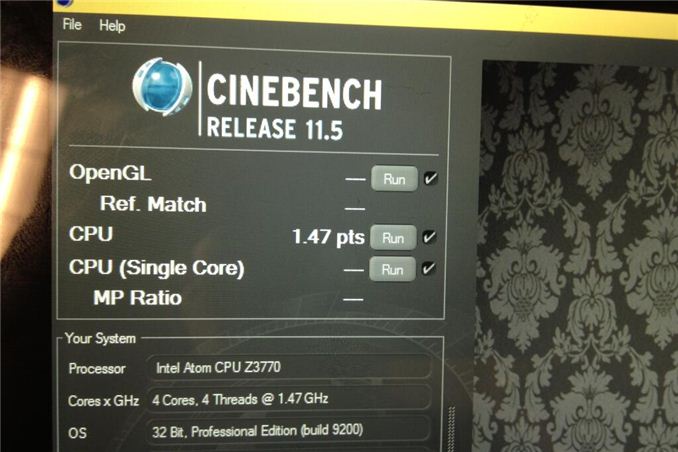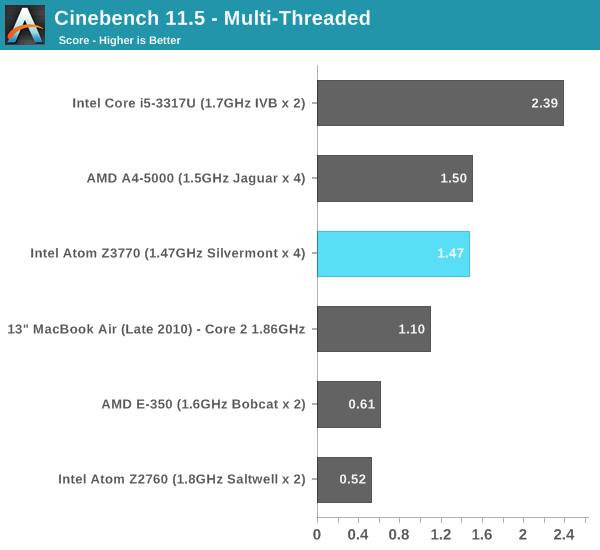Intel Teases Baytrail Performance with Atom Z3770 Cinebench Score
by Anand Lal Shimpi on September 4, 2013 12:49 PM EST- Posted in
- CPUs
- Intel
- Mobile
- Silvermont
- Tablets

Intel's lone ranger and Principal Engineer, Francois Piednoël, published one of the first semi-official Baytrail benchmarks on his Twitter feed earlier today. The score is for the unannounced Atom Z3770, a quad-core Silvermont based (4C/4T) Baytrail implementation running at a nominal frequency of 1.47GHz (with I assume a > 2GHz max turbo). Francois was careful to only run the multithreaded Cinebench 11.5 test, tossing out a score of 1.47.
To put this score in perspective we need to dig into some of our own reviews. AMD's A4-5000, a quad-core Kabini based SoC running at 1.5GHz, manages a score of 1.5 in the same test. This is also roughly 86% of the performance of a dual-core Sandy Bridge based Pentium processor running at 2.2GHz. Compared to a dual-core Atom Z2760 (Clovertrail) the Atom Z3770 delivers nearly 3x the performance. Finally, this Baytrail SKU delivers similar performance to a mid-2GHz mobile Penryn based Core 2 Duo. Let that sink in for a moment - this tablet SoC delivers better multithreaded FP performance than a 2010 Macbook Air. The quad-core Silvermont vs. dual-core Penryn comparisons are a little unfair as there tends to be no replacement for extra cores in these thread heavy benchmarks. If Intel is able to equal a Core 2 Duo's single threaded performance however...

Single threaded performance typically scales down quite linearly in Cinebench, but that's assuming that single core turbo frequencies aren't insane. Regardless it's probably safe to assume a single threaded Cinebench 11.5 score somewhere north of a 1.5GHz Jaguar. We are also only looking at FP performance here, which is less important for most consumer uses than integer based workloads.
It's interesting to note that the test system (likely a tablet) seems to be running a 32-bit version of Windows. As there are no connected standby enabled versions of 64-bit Windows, that's likely why we're seeing the 32-bit version used here.
Obviously the big unknown here is power consumption. As Baytrail is destined for tablets, I'd expect lower average power than pretty much all of our comparison targets in the graph above. The big question I have is whether or not this is finally performance that is good enough. Although Clovertrail could run legacy Windows applications, it wasn't fast enough to actually run heavy legacy apps well. Paired with a decent IO subsystem (something I'm doubtful most OEMs will deploy), I feel like Baytrail could be on the cusp of delivering performance that's good enough. Part of the problem here is that we're only looking at multithreaded performance, which obviously looks pretty reasonable on a quad-core part. How well Intel is able to deliver good single threaded performance will really determine whether or not Baytrail makes for a great platform.
With IDF 2013 next week I'm guessing we'll see a lot more of Baytrail's performance soon enough.










33 Comments
View All Comments
Lonyo - Wednesday, September 4, 2013 - link
So based on that, it's potentially 73% faster than the old Atom clock for clock, assuming perfect scaling..25 points per GHz per core compared to .1444 points per GHz for Saltwell.
beginner99 - Wednesday, September 4, 2013 - link
What I consider important is that this is a FP test and Silvermont improves more on integer side so it's safe to say it will beat the same A4 in integer loads (eg. the stuff that is actually relevant on tablets).karasaj - Wednesday, September 4, 2013 - link
Isn't saltwell .26 per core? While Baytrail would be .375 per core? .52/2 (saltwell only has 2 cores) vs ~1.5 / 4 (baytrail has four)?Anand Lal Shimpi - Wednesday, September 4, 2013 - link
Keep in mind that Clovertrail is 2 cores/4 threads, so per core utilization is higher than a standard 2 core/2 thread part.karasaj - Wednesday, September 4, 2013 - link
/oh i forgot about that. Somewhere in between then?Khato - Wednesday, September 4, 2013 - link
Quick check for single threaded Cinebench 11.5 scores for the Z2760 yields 0.18. So normalizing for frequency (assuming that the Z3770 is actually running at 2.4 GHz) would have Baytrail roughly 53% faster.Gondalf - Wednesday, September 4, 2013 - link
Z3770 is not running at 2.4Ghz four cores active here. Likely this 3W soc has only a very little factory fixed turbo with four cores up, so your calculation has not common sense. No, actually you can not calculate the single thread performance.Moreover remember that A4-5000 is 15W TDP so is not competitive at all in tablets, the only feasible Amd soc is clocked at 1Ghz dual core only. This is the reason Kabini actually is very weak in mobile.
silverblue - Thursday, September 5, 2013 - link
Again, TDP rears its ugly head. The A4-5000 may be rated at 15W TDP but that doesn't mean it uses it, especially not in every day scenarios.Consider the following link:
http://www.techspot.com/review/671-amd-a4-5000-kab...
Assume that the A4-5000 idles at under 1W (I've heard it's actually 0.77W). This means that the chip uses 8W more in Prime95, for a total of 9W. An extra 6W is consumed if FurMark is thrown into the mix as that large GPU fires up. You would indeed get your 15W usage there... but certainly not when you're running a CineBench test?
Also, consider this:
http://www.tomshardware.com/reviews/kabini-a4-5000...
Sure, Kabini will use more power, but not drastically so, and it always depends on the usage scenario anyway. Considering the large GPU, higher process node and lack of a dual channel memory controller, Kabini will do quite well in terms of power but is still leaving a little potential performance on the table. In any case, I imagine its GPU will run rings around Bay Trail's.
Gondalf - Thursday, September 5, 2013 - link
Same is valid for Intel Soc, Baytrail T 3W TDP is with GPU on die up and running, so very likely under cpu stress the four cpus consume less than 2W at 1.47 Ghz. In my country 9W is MORE than FOUR times 2W.It is a fact that this 3W soc can sport the same throughput of a 15W Kabini.
No, you can not try to defend Kabini, he is not born for mobile but for a console instead. Not a chance, in fact nobody use it waiting for Baytrail, this really counts.
We'll see next year with the Soc refresh, maybe will be better still i have some doubts because the process is the same and the arc too.
mrdude - Wednesday, September 4, 2013 - link
I'm pretty sure that beating an A4 in integer workloads isn't all that relevant on tablets... :PThe more pertinent questions here are what's the price, tdp, performance, and what are the design wins? It's safe to assume we'll see a variety of Win8 x86 devices, but, again, we're talking about what's relevant on tablets :D